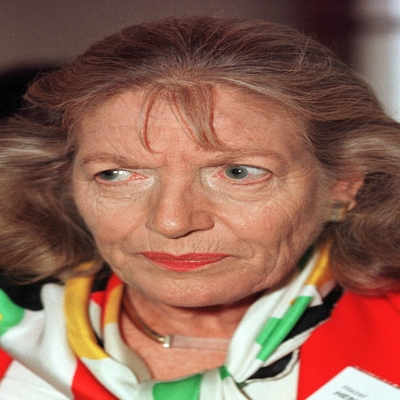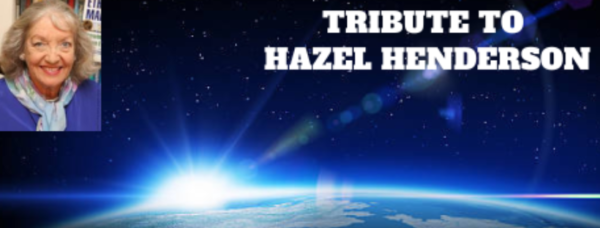Coming home from the park in the mid-1960s, Hazel Henderson would draw a bath to wash the soot off her young daughter. Ash would fall from the New York City sky as incinerators burned through garbage, and the horizon would disappear behind a yellowish haze. Some days the air was so filthy it was difficult to breathe, and for a time the soot and smog were all Ms. Henderson could talk about.
“You know, dear, you’re getting to be a nut about this pollution,” she later recalled her husband saying. “Now why don’t you go and talk to the mayor and leave me alone.”Ms. Henderson, a British-born homemaker who had grown up hearing stories about the toxic “London fog,” took his advice, writing letters to Mayor Robert F. Wagner Jr. — as well as to local TV and radio stations — while launching a successful campaign to get air-pollution readings published on the evening news.
Backed by other mothers whom she met while handing out leaflets during her walks through the park, she won new restrictions on air pollution, notably after smog blanketed the city over Thanksgiving weekend in 1966.
“We got what we wanted,” she later told the Australian Financial Review, “but not before the New York business community branded us as communists. That was my first lesson in how hard entrenched powers resist change.”
Ms. Henderson went on to spend decades campaigning for social change, turning from air pollution to broader issues of environmental justice, gender equality and economic development. A self-described “independent, self-employed futurist,” she wrote nine books, published a syndicated newspaper column and lectured around the world, influencing political activists such as Ralph Nader, who cited her work while running for president in 2000 as the Green Party nominee.

She was 89 when she died — or “went virtual,” as she termed it — on May 22 at her home in St. Augustine, Fla. The cause was complications from cancer, said Linda C. Crompton, the chief executive of Ethical Markets, a media company that Ms. Henderson founded to promote “the evolution of capitalism.”
A feisty author and environmental activist, Ms. Henderson never graduated from college and largely worked outside established institutions. “I always knew I was unemployable,” she once told the St. Petersburg Times. “I would have been fired off any job for insubordination.”
But she built a long career as a gadfly thinker, known for arguing that economic growth had to be balanced with environmental protections and for championing the maxim “think globally, act locally.” The Christian Science Monitor once described her as “a terrific synthesizer of new modes of thought, one who would not be offended by critics who call her a crank.”
Through Citizens for Clean Air, the environmental group she helped organize in New York in 1964, she lobbied for new local, state and federal pollution legislation, targeting pollution caused by automobiles — “The internal combustion engine should be in a museum,” she declared — as well as power plants and trash incinerators. The group grew to more than 20,000 members, some 75 percent of whom were women, according to historian Adam Rome’s book “The Genius of Earth Day.”
“The politicians had said there would be no interest!” Ms. Henderson told the Sydney Morning Herald, recalling one of her early campaigns for new pollution regulations. “Mothers and baby carriages went down to City Hall, and not one councilor dared vote against it. It was very gentle, and very politically persuasive.”
As part of her crusade against air pollution, Ms. Henderson taught herself economics, the better to spar with business executives and academics who insisted that dirty air was simply a cost of doing business. She became a fierce critic of economic orthodoxies, likening the field to a form of “brain damage,” and condemned the use of metrics like gross national product (GNP) as a yardstick for national success.
In place of GNP she suggested her own report card for the country’s economy, factoring in literacy rates, life expectancy, child development and other metrics.
Ms. Henderson shared her views with Sen. Robert F. Kennedy (D-N.Y.) in 1967, after arranging for a helicopter ride around New York “to show him,” she later said, “all the sources of air pollution and why our group proposed correcting our national GNP.” The journey apparently made an impression: While running for president the next year, Kennedy gave a speech lamenting that the nation “seemed to have surrendered personal excellence and community values in the mere accumulation of material things.”
The GNP, Kennedy added, “measures neither our wit nor our courage, neither our wisdom nor our learning, neither our compassion nor our devotion to our country. It measures everything, in short, except that which makes life worthwhile. And it can tell us everything about America except why we are proud that we are Americans.”
Ms. Henderson later published books including “The Politics of the Solar Age” (1981), in which she set about “defrocking the economics priesthood,” arguing that “three hundred years of snake oil” had resulted in high inflation and unemployment, as well as depleted natural resources and a planet on the brink of ecological disaster.
“One might even say that the beneficent ‘invisible hand’ envisioned by Adam Smith has become for increasing numbers of Americans a clumsy, heedless ‘invisible foot,’ which tramples on social, human, and environmental values,” she wrote, while advocating a new economic system fueled by renewable energy sources.
“Henderson writes in a lively, well-informed, deliberately outrageous style about matters important to us all,” wrote New York Times reviewer Langdon Winner. “In her best moments she seems a capable successor to the late E.F. Schumacher,” the German-British economist who believed that “small is beautiful.” “Those weary of threadbare liberal economics and repelled by present-day conservative nostrums will find here a great deal to ponder,” Winner added.
Some academics were more critical of her work, not that Ms. Henderson cared.
“My analysis was vilified by economists as wrong-headed and absurd,” she wrote in a follow-up book, “Building a Win-Win World” (1996). “I learned to interpret this as evidence that I was hitting home.”
She was born Hazel Mustard in Bristol, England, on March 27, 1933. Her father was a businessman, and she described her mother as a proto-environmentalist who grew her own fruit and vegetables, raised her own chickens and bought fish from the local pier.
After graduating from high school, Ms. Henderson worked as a switchboard operator, saleswoman and hotel clerk. She married Carter Henderson, a former London correspondent for the Wall Street Journal, in 1957, around the time she moved to New York. Their marriage ended in divorce.
Ms. Henderson wrote for publications ranging from Harvard Business Review to the Nation, and was a fellow or board member at think tanks including the World Business Academy, Worldwatch Institute and Council on Economic Priorities. In the late 1970s, she was an adviser to the U.S. Office of Technology Assessment and served on panels of the National Science Foundation and the National Academy of Engineering.
As support for green energy diminished during the Reagan administration, Ms. Henderson became involved in what she called “the socially responsible investment movement,” serving on the advisory council of the Calvert Social Investment Fund. “That was like crossing the Rubicon for me, deciding to be part of capitalism,” she said.
Backed by her second husband, Alan Kay, she founded Ethical Markets Media in 2004. Her husband, the founder of an electronic Wall Street trading platform called AutEx, died in 2016. Survivors include a daughter from her first marriage, Alexandra Leslie Camille Henderson; and a grandson.
“Never doubt for a moment that a small group of dedicated citizens can change the world,” Ms. Henderson liked to say, paraphrasing her friend Margaret Mead, the anthropologist. “Indeed, it’s the only thing that ever has.”
